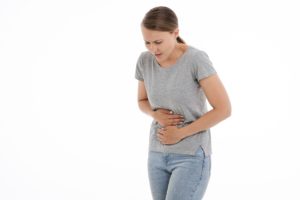Written by Taylor Woosley, Staff Writer. Results of the one-day one-dose study show that consumption of a turmeric-boswellia-sesame formulation significantly reduced menstrual pain intensity and was 20.19 times more effective than placebo.
 Dysmenorrhea is one of the most common gynecological conditions that most child-bearing females suffer from during menstruation and it is classified into primary dysmenorrhea (PD) or secondary dysmenorrhea1. PD is defined as spasmodic and painful cramps in the lower abdomen that begin shortly before or at the onset of menses in the absence of any pelvic pathology2. The pathophysiology of PD is due to increased and/or abnormal uterine activity because of increased production and release of prostaglandins3.
Dysmenorrhea is one of the most common gynecological conditions that most child-bearing females suffer from during menstruation and it is classified into primary dysmenorrhea (PD) or secondary dysmenorrhea1. PD is defined as spasmodic and painful cramps in the lower abdomen that begin shortly before or at the onset of menses in the absence of any pelvic pathology2. The pathophysiology of PD is due to increased and/or abnormal uterine activity because of increased production and release of prostaglandins3.
Nonsteroidal anti-inflammatory drugs (NSAIDs) are the primary treatment for PD; however, these drugs are associated with many gastrointestinal adverse events4. Boswellia serrata and Curcuma longa are widely used for management of inflammation and include several compounds with important antioxidant and anti-inflammatory activities5. Furthermore, sesame has been touted in traditional medicine as a helpful treatment for menstrual irregularities6.
Divya-Agarwal et al. conducted a randomized, double-blinded, placebo-controlled study to analyze the effectiveness of a turmeric-boswellia-sesame formulation on pain symptoms of primary dysmenorrhea. Subject inclusion consisted of healthy female participants aged 18 to 35 years experiencing regular menstrual cycles, and having a self-reported history of primary dysmenorrhea with at least moderate menstrual cramp pain. Participants were placed into either the turmeric-boswellia-sesame formulation group (n = 30) (two soft gels of 500 mg) or placebo (n = 30) (two soft gels of 500 mg) for a single-day single-dose intervention. The treatment product contained turmeric extract (95%), 28% (containing NLT 26.6% total curcuminoids), boswellia serrata extract, 10 (containing AKBA NLT 1%), and sesame oil, 62%.
Pain intensity was measured during screening using the Categorical Pain Relief Scale (PRS) and the Numerical Rating Scale for Pain (NRS). Subjects took the assigned soft gels when menstrual cramp pain was ≥5 in severity using the NRS questionnaire. Before and after consumption of the treatment, participants wrote down the pain intensity rating every 30 minutes up to 6 hours pre- and post-dose for the assessment of the sum of pain intensity difference (SPID) and the assessment of total pain relief (TOTPAR). Primary study outcomes included changes in TOTPAR and SPID.
The Mann-Whitney U test was used to analyze NRS-derived endpoint SPID to compare between placebo and intervention. A mixed model repeated measures with fixed effects for time, treatment, and treatment-time interaction was utilized to assess pain intensity difference (PID) at different timepoints from baseline. The Mann-Whitney U test was used to compare TOTPAR between the intervention and placebo groups. Significant findings of the study are as follows:
- The intervention group experienced a significant reduction in menstrual pain intensity. SPID at 6 hours in the intervention group showed a significant difference (p < 0.0001) compared to placebo and was 20.19 times more effective than placebo.
- 3% of subjects in the treatment group reported the turmeric-boswellia-sesame formulation as an excellent pain reliever, while 83.3% in the placebo group reported insignificant pain relief.
Results of the study show that the turmeric-boswellia-sesame formulation significantly improved pain symptoms and severity of primary dysmenorrhea. The significant improvements in pain severity suggest that a combination of turmeric, boswellia, and sesame is a safe alternative for pain relief in menstruating females. Study limitations include the small sample size and the one-day duration of the study.
Source: Agarwal, Divya, and Priyanka Chaudhary. “Effect of Turmeric–Boswellia–Sesame Formulation in Menstrual Cramp Pain Associated with Primary Dysmenorrhea—A Double-Blind, Randomized, Placebo-Controlled Study.” Journal of Clinical Medicine 12, no. 12 (2023): 3968.
© 2023 by the authors. Licensee MDPI, Basel, Switzerland. This article is an open access article distributed under the terms and conditions of the Creative Commons Attribution (CC BY) license (https://creativecommons.org/licenses/by/4.0/).
Click here to read the full text study.
Posted September 12, 2023.
Taylor Woosley studied biology at Purdue University before becoming a 2016 graduate of Columbia College Chicago with a major in Writing. She currently resides in Glen Ellyn, IL.
References:
- Karout S, Soubra L, Rahme D, Karout L, Khojah HMJ, Itani R. Prevalence, risk factors, and management practices of primary dysmenorrhea among young females. BMC Womens Health. Nov 8 2021;21(1):392. doi:10.1186/s12905-021-01532-w
- Itani R, Soubra L, Karout S, Rahme D, Karout L, Khojah HMJ. Primary Dysmenorrhea: Pathophysiology, Diagnosis, and Treatment Updates. Korean J Fam Med. Mar 2022;43(2):101-108. doi:10.4082/kjfm.21.0103
- Azagew AW, Kassie DG, Walle TA. Prevalence of primary dysmenorrhea, its intensity, impact and associated factors among female students’ at Gondar town preparatory school, Northwest Ethiopia. BMC Womens Health. Jan 6 2020;20(1):5. doi:10.1186/s12905-019-0873-4
- Matsas A, Sachinidis A, Lamprinou M, Stamoula E, Christopoulos P. Vitamin Effects in Primary Dysmenorrhea. Life (Basel). Jun 1 2023;13(6)doi:10.3390/life13061308
- D’Amico R, Impellizzeri D, Cordaro M, et al. Regulation of Apoptosis and Oxidative Stress by Oral Boswellia Serrata Gum Resin Extract in a Rat Model of Endometriosis. Int J Mol Sci. Dec 5 2022;23(23)doi:10.3390/ijms232315348
- Vollmer DL, West VA, Lephart ED. Enhancing Skin Health: By Oral Administration of Natural Compounds and Minerals with Implications to the Dermal Microbiome. Int J Mol Sci. Oct 7 2018;19(10)doi:10.3390/ijms19103059
